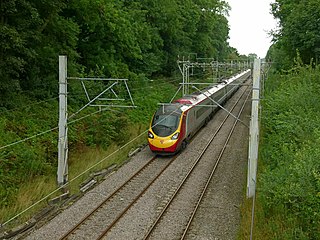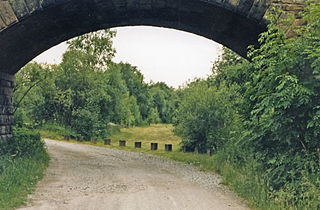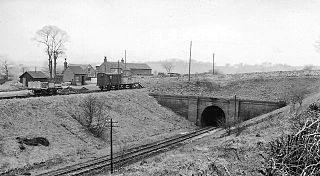
The Leek and Manifold Valley Light Railway (L&MVLR) was a narrow gauge railway in Staffordshire, England that operated between 1904 and 1934. The line mainly carried milk from dairies in the region, acting as a feeder to the 4 ft 8+1⁄2 instandard gauge system. It also provided passenger services to the small villages and beauty spots along its route. The line was built to a 2 ft 6 in narrow gauge and to the light rail standards provided by the Light Railways Act 1896 to reduce construction costs.

The North Staffordshire Railway (NSR) was a British railway company formed in 1845 to promote a number of lines in the Staffordshire Potteries and surrounding areas in Staffordshire, Cheshire, Derbyshire and Shropshire.

The Churnet Valley Railway is a preserved standard gauge heritage railway in the Staffordshire Moorlands of Staffordshire, England. It operates on part of the former Churnet Valley Line which was opened by the North Staffordshire Railway. The railway is roughly 10.5 miles (16.9 km) long from Kingsley and Froghall to Ipstones. The land from Leek Brook Junction to Ipstones was opened by Moorland & City Railways (MCR) in 2010 after they took a lease out from Network Rail. This has subsequently been purchased by the Churnet Valley Railway. The main stations along the line are Kingsley and Froghall, Consall, Cheddleton and Leek Brook. An extension to the town of Leek which will act as the northern terminus of the line was completed in late 2024. The line between Leek and Waterhouses has also been reopened as part of the heritage railway as far as Ipstones.

Uttoxeter railway station serves the town of Uttoxeter, Staffordshire, England. It is on the Crewe–Derby line, which is also a Community rail line known as the North Staffordshire line. The station is owned by Network Rail and managed by East Midlands Railway.

Cheddleton railway station is a former passenger railway station of the North Staffordshire Railway (NSR) and is now a preserved station on the Churnet Valley Railway in Staffordshire, England].

Leek Brook railway station is a passenger station in Staffordshire, Great Britain.
The Churnet Valley line was one of the three original routes planned and built by the North Staffordshire Railway. Authorised in 1846, the line opened in 1849 and ran from North Rode in Cheshire to Uttoxeter in East Staffordshire. The line was closed in several stages between 1964 and 1988 but part of the central section passed into the hands of a preservation society and today operates as the Churnet Valley Railway.

Macclesfield Hibel Road railway station was a railway station serving the town of Macclesfield in Cheshire, England. It was opened as a joint station by the North Staffordshire Railway (NSR) and the London and North Western Railway (LNWR) on 13 July 1849, with the opening of the NSR route to Uttoxeter via North Rode and Leek and it replaced an earlier, temporary, LNWR station at Beech Bridge. Built right at the point where the track of the two companies made an end-on junction, the station was managed by a joint committee of the two companies.

Bosley railway station served the village of Bosley, Cheshire. The station was opened by the North Staffordshire Railway in September 1849 as part of the Churnet Valley line.

North Rode railway station originally North Rode junction served the village of North Rode, Cheshire. The station was opened by the North Staffordshire Railway (NSR) on 18 June 1849 and formed the junction of the Churnet Valley Line from the main NSR line between Stoke-on-Trent and Macclesfield.

Cliffe Park railway station was opened by the North Staffordshire Railway (NSR) in 1905 on the Churnet Valley line to attract visitors to Rudyard Lake, which the NSR were trying to develop as a leisure and tourist attraction including a golf course. The station was originally named Rudyard Lake and was at the northern end of the lake. There were no settlements nearby and consequently the station had no goods facilities. There was one siding but this was used more for stabling excursion trains rather than freight vehicles.

Rudyard railway station served the village of Rudyard, in Staffordshire, England.
Waterhouses railway station was a railway station that served the village of Waterhouses, Staffordshire. It was opened jointly by the North Staffordshire Railway (NSR) and the Leek and Manifold Valley Light Railway (L&MVLR) in 1905 and closed in 1943.

St Edward's Hospital was a mental health facility at Cheddleton in Staffordshire, England. The hospital closed in 2002 and was converted into apartments and houses.

Ipstones railway station was a railway station that served the village of Ipstones, Staffordshire. It was opened by the North Staffordshire Railway (NSR) in 1905 and closed to passenger use in 1935, but remained open to freight traffic until 1964.

Bradnop railway station was a railway station that served the village of Bradnop, Staffordshire. It was opened by the North Staffordshire Railway (NSR) in 1905 and closed to passenger use in 1935, but remained open to freight traffic until 1964.
The Waterhouses branch line was a railway built by the North Staffordshire Railway to link the small villages east of Leek, Staffordshire with Leek, the biggest market town in the area. The railway opened in 1905 but closed to passengers in 1935. Freight continued on the line though until 1988, when the line was mothballed as the traffic from the quarries at Caldon Low ceased.

Winkhill railway station was a railway station that served the hamlet of Winkhill, Staffordshire. It was opened by the North Staffordshire Railway (NSR) in 1910 and closed to passenger use in 1935, but remained open to freight traffic until 1964.
Caldon Low Halt railway station was a railway station near the hamlet of Cauldon, Staffordshire. It was opened by the North Staffordshire Railway (NSR) in 1905 and closed in 1935.
Leek railway station is the proposed and future terminus of the Churnet Valley Railway and is currently awaiting construction. It will be the second railway station in Leek.















